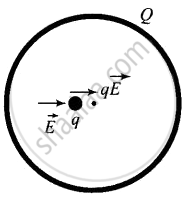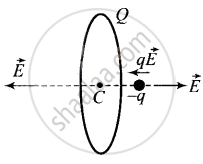Advertisements
Advertisements
Question
A positive charge Q is uniformly distributed along a circular ring of radius R. A small test charge q is placed at the centre of the ring (figure). Then

- If q > 0 and is displaced away from the centre in the plane of the ring, it will be pushed back towards the centre.
- If q < 0 and is displaced away from the centre in the plane of the ring, it will never return to the centre and will continue moving till it hits the ring.
- If q < 0, it will perform SHM for small displacement along the axis.
- q at the centre of the ring is in an unstable equilibrium within the plane of the ring for q > 0.
Options
a and b
b and c
c and d
a, b, c and d
Solution
a, b, c and d
Explanation:
The positive charge Q is uniformly distributed along the circular ring then electric field at the centre of the ring will be zero, hence no force is experienced by the charge if it is placed at the centre of the ring.
Now the charge is displaced away from the centre in the plane of the ring. There will be a net electric field opposite to displacement that will push back the charge towards the centre of the ring if the charge is positive. If the charge is negative, it will experience a net force in the direction of displacement and the charge will continue moving till it hits the ring. Also, this negative charge is in an unstable equilibrium.

Charge placed at the centre of the ring

The charge displaced away from the centre of the ring

The direction of the electric field on the axis of a positively charged ring is along the axis of the ring and away from the centre of the ring. If a negative charge is shifted away from the centre along the axis of the ring, charge will experience a net force towards the centre and return to the centre and will perform SHM for small displacement along the axis.
APPEARS IN
RELATED QUESTIONS
What is the force of repulsion if each sphere is charged double the above amount, and the distance between them is halved?
Suppose the spheres A and B in Exercise 1.12 have identical sizes. A third sphere of the same size but uncharged is brought in contact with the first, then brought in contact with the second, and finally removed from both. What is the new force of repulsion between A and B?
(a) Consider an arbitrary electrostatic field configuration. A small test charge is placed at a null point (i.e., where E = 0) of the configuration. Show that the equilibrium of the test charge is necessarily unstable.
(b) Verify this result for the simple configuration of two charges of the same magnitude and sign placed a certain distance apart.
In charging by Induction, a metallic object is charged ______.
A point charge + q is placed at a distance d from an isolated conducting plane. The field at a point P on the other side of the plane is ______.
Two small balls having the same mass and charge and located on the same vertical at heights h1 and h2 are thrown in the same direction along the horizontal at the same velocity v. The first ball touches the ground at a distance l from the initial vertical. At what height H2 will the second ball be at this instant ? The air drag and the effect of the charges induced on the ground should be neglected.
